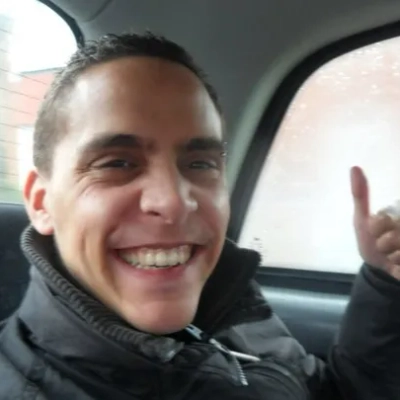25 Unconventional Advertising Tactics that Actually Work
In the ever-evolving world of advertising, conventional methods are no longer enough to capture audience attention. This article explores unconventional advertising tactics that have proven surprisingly effective, backed by insights from industry experts. From breaking digital fatigue with physical gifts to creating immersive brand experiences in unexpected places, these strategies offer fresh perspectives on engaging customers in today's competitive marketplace.
- Break Digital Fatigue with Physical Gifts
- Surprise Customers in Micro-Moments
- Turn Interviews into Micro-Ad Campaigns
- Create Scarcity with Extended Demo Waitlists
- Host Property Transformation Open Houses
- Partner with Local Micro-Creators
- Build Trust Through Casual Neighborhood BBQs
- Showcase Authentic Behind-the-Scenes Moments
- Transform Products into Moving Advertisements
- Leverage Targeted Facebook Group Collaborations
- Engage Users with AR Product Try-Ons
- Offer Free Advice at Local Flea Markets
- Encourage Guest Feedback on Chalkboards
- Provide Free Moving Help at Storage Facilities
- Create Immersive Brand Experiences in Cabs
- Design Interactive Beer Mats for Engagement
- Tell Local Stories in Community Newsletters
- Spark Curiosity with Mysterious Lost Item Flyers
- Make Ads Saveable to Mobile Wallets
- Utilize AI for Dynamic Video Ad Creation
- Target Highly Engaged Website Visitors
- Embed Brand in Interactive Industry Tools
- Collaborate on Industry Rankings for Credibility
- Learn from Unconventional Marketing Accidents
- Disguise Ads as User-Generated Content
Break Digital Fatigue with Physical Gifts
One of the SaaS clients we worked with wanted to get small business owners in the U.S. to use their software, so we sent $5 Visa gift cards in the mail to a very precise segment of local business owners. We included an individualized note and specific action copy that linked directly to the customer's landing page. Although the campaign cost per recipient was higher than typical email or social ads, the open and visit rate was above 70%, and conversions were over 3x our previous cold outreach endeavors. Holding the physical asset in their hands broke through digital fatigue and grounded the option as real, personal, and trustworthy.
For anyone else attempting to do this, I can tell you that precision and authenticity really matter. Focus on high-fit prospects to give them the gift they are most likely to find relevant and make the landing page experience seamless (no long forms, just a simple next step). Make the message short, centered around one reward, and connect it directly to the value being delivered by your SaaS. It's also essential to monitor ROI closely. For us, the long-term value of sales-qualified leads far surpassed our initial investment. This tactic works best when the audience least expects it — and that's really the point of this approach.

Surprise Customers in Micro-Moments
One of the most unconventional advertising tactics I have seen deliver strong results is what I call "contextual surprise placement." Several years ago, while consulting for a global consumer electronics brand, we faced a saturated market where conventional digital ads blended into the background. Instead of fighting for attention in the usual digital and physical spaces, we identified highly specific, often-overlooked micro-moments in the customer journey and placed our brand messaging there. For example, we negotiated with a popular ride-sharing app to sponsor in-app messages that only appeared when a user's ride was delayed or rerouted. The message offered a branded playlist and an exclusive discount code for our noise-canceling headphones, positioned as a way to improve a frustrating wait.
This tactic brought two key advantages. First, it reached customers at an emotionally charged moment, making the message relevant and memorable. Second, it side-stepped the ad blindness typical in standard channels. Measuring direct conversions, we saw a higher-than-expected redemption rate and significant lift in brand recall for those exposed to these timely messages compared to control groups.
For those looking to replicate this approach, my advice is to start by mapping the entire customer journey in granular detail. Identify not just the obvious touchpoints, but the hidden moments of friction or anticipation that competitors ignore. Then seek partnerships with platforms or services that own those moments, even if they are outside traditional advertising channels. The creative challenge is crafting messaging that feels native and genuinely helpful in that context, rather than opportunistic.
From my experience leading ECDMA initiatives and consulting for global brands, the real impact comes when you surprise your audience with relevance where they least expect it. This demands operational agility and a willingness to experiment with nontraditional partners, but when executed thoughtfully, it can cut through the noise far more effectively than increasing spend on mainstream ads.
Turn Interviews into Micro-Ad Campaigns
One unconventional tactic that has worked for me is turning high-value, educational media interviews into micro-ad campaigns. Instead of running traditional ads, I've taken a 30-60 second clip from a podcast or video interview where I'm giving useful, non-promotional advice, added captions and a subtle CTA, and run it to a highly targeted audience. Because it feels like organic thought leadership rather than an ad, engagement and watch time are significantly higher, and leads come in warmer. My advice: pick clips that solve a specific problem, keep the tone authentic, and lead viewers to the next step without a hard sell.

Create Scarcity with Extended Demo Waitlists
We created a "Book a Demo" campaign for a software client with an intentional twist: the next available slot was five months later. This wasn't an accident. We made it appear as if their product was so highly anticipated that prospects would have to wait months to test it, creating a feeling of anticipation and scarcity.
When placed on the app stores, demo requests increased by 40%, which prompted the client to adopt a waitlist (with 80+% follow-up engagement) as people began to perceive this as a unique opportunity they shouldn't miss. The scarcity experience eventually led to prospects viewing demos as valuable opportunities rather than just another sales call.
This was an early indicator of the strategy's success, where we aimed for the best of both worlds: scarcity without making the product entirely unavailable. We nurtured the waiting prospects by sending educational content, case studies, and relevant product updates to keep them engaged until their demo five months later. The goal wasn't to artificially raise urgency, but rather to position the offer as one with market value and a competitive edge. When executed correctly, this approach absolutely becomes a facilitator of trust and excitement instead of a hindrance.

Host Property Transformation Open Houses
I've had remarkable success with 'Property Transformation Open Houses' where we invite the entire neighborhood to view a home before, during, and after renovation. This builds tremendous trust because people can see the quality of our work firsthand and understand how we're improving their community. Homeowners love watching the transformation process, and it's created a pipeline of referrals from neighbors who eventually need to sell. If you want to try this, be genuinely transparent about your process and create opportunities for community members to feel involved in the positive changes happening on their street.

Partner with Local Micro-Creators
One unconventional advertising tactic that has worked exceptionally well at Ranked is geo-targeted micro-campaigns using community creators instead of broad national ads. Rather than investing heavily in generic display or social campaigns, we partnered with micro and nano creators in specific neighborhoods, ZIP codes, or local scenes, allowing them to authentically promote products and collect real-time insights.
For example, for a sneaker launch, we activated creators across five key urban ZIP codes, each creating local content tailored to their audience. The result? Engagement and conversion rates were three times higher than the nationwide digital campaign we had previously run, and the brand gained hyper-local insight that informed product restocking and messaging.
Advice for others: don't replicate the tactic blindly. Focus on understanding the local audience, choose creators with authentic reach in that community, and measure results at the micro level. The key is precision, authenticity, and data-driven iteration; otherwise, even unconventional tactics fall flat.
Build Trust Through Casual Neighborhood BBQs
One unconventional tactic I've had great results with is hosting casual, no-pressure backyard BBQs in neighborhoods where I buy homes--inviting local residents, not clients. Grilling burgers and simply chatting builds trust and often leads to honest conversations about real estate needs down the line. If you want to give it a shot, keep it relaxed and authentic--it's the personal connection, not the pitch, that gets people to remember you when it matters.

Showcase Authentic Behind-the-Scenes Moments
One of our most unexpectedly successful "ads" at OSSIO was actually a behind-the-scenes film of our team getting ready for a product training. It featured real moments of people conversing, joking, and outlining the significance of our work, with no editing or script.
It struck a far deeper chord than a well-planned campaign. Partners, patients, and doctors said that rather than only learning about a device, they felt as though they were "meeting" us.
My recommendation? Don't undervalue the importance of demonstrating your process and your personnel. A genuine, human peek can break through the clutter and establish a stronger connection in a world full of polished marketing.

Transform Products into Moving Advertisements
Hello,
Our most successful advertising tactic wasn't digital at all; it was putting our reclaimed stone on flatbed trucks and parking them at construction hotspots. Instead of billboards or social ads, we turned the product itself into a moving advertisement. Architects and contractors stopped in traffic to photograph the loads, and several major commissions began with a simple phone call that started with, "I saw your truck on the 405." The lesson here: in a world oversaturated with polished campaigns, raw authenticity stands out. My advice: find a way to showcase your product in its most natural, unfiltered form, and let curiosity do the heavy lifting.
Best regards,
Erwin Gutenkust
CEO, Neolithic Materials
https://neolithicmaterials.com

Leverage Targeted Facebook Group Collaborations
At a previous company, we collaborated with the owner of a large Facebook group and compensated him for sharing our content as if it were a regular post in his community. The agreement was straightforward. We provided him with a flat fee for each post, typically around $200, plus $0.01 for every click it generated. We tracked all activity using UTM parameters to measure results.
We were selective about the content we shared. Only posts we were confident the audience would appreciate were chosen. After the first year of implementing this strategy, it had driven more than a quarter of a million clicks to our site at an average cost of $0.02 per click.
The logical question is whether these clicks were valuable. To determine this, we created an engaging quiz based on The Office that revealed which character someone most resembled. By analyzing their responses, we discovered that more than 60% of the people engaging were a strong match for our ideal client profile.
My recommendation for anyone seeking to replicate this approach is to prioritize relevance. Don't simply pay for placement. Ensure your content feels native to the group and genuinely resonates with its members. This is what transforms an unconventional tactic into a sustainable growth channel.

Engage Users with AR Product Try-Ons
One unconventional advertising tactic I've seen success with was using augmented reality filters on social media to let users "try on" our product virtually. We ran a campaign where people could see our sunglasses on their faces through Instagram, and it generated a ton of organic shares. My advice for others trying to replicate this is to focus on making it genuinely interactive and fun rather than just a gimmick. The engagement comes when users feel like they're experiencing something new, not just seeing an ad. Also, track the conversion path carefully—sometimes the buzz is high, but purchases only follow if the experience leads smoothly to a call-to-action. In our case, adding a direct "shop now" link inside the filter made all the difference.

Offer Free Advice at Local Flea Markets
One unconventional tactic I've used with success is setting up a simple booth at local flea markets--not to sell anything, but to offer free advice to homeowners who stop by. People feel more comfortable asking questions in that casual setting, and it's led to conversations I'd never get through traditional advertising. If you want to try this, skip the hard sell--just show up where your community already gathers and make yourself available as a resource. The trust you build there is worth more than any billboard.

Encourage Guest Feedback on Chalkboards
One unconventional tactic that has consistently surprised me is leaving a small chalkboard in my Airbnb rentals for guests to write reviews or recommendations for future visitors. Not only does it encourage honest, positive feedback right at the property, but guests often snap a photo and share it on social media, tagging us. If you want to try something similar, make it fun and personal. When guests see that you care about their experience, they often do the advertising for you.

Provide Free Moving Help at Storage Facilities
Here's an unusual strategy that paid off for us: During prime moving season, I set up a free 'moving truck loading' station outside busy self-storage facilities. This involved helping people quickly shift heavy items while answering honest real estate questions as we worked side by side. It led to genuine connections and eventual deals because people appreciated unexpected hands-on help during stressful transitions. My tip: Look for those high-pressure moments where you can physically assist your community. Showing you understand their challenges builds lasting trust faster than any brochure.

Create Immersive Brand Experiences in Cabs
One of the most unconventional advertising tactics I've seen work wonders is cab advertising. Think about it: most people expect ads on billboards, bus shelters, or even their phones, but they rarely anticipate seeing a moving story right on the cab they're riding in or passing by. That little element of surprise is what makes it stick.
I remember a campaign where branded cabs weren't just painted with logos; they were designed like moving extensions of the brand's world. Passengers didn't just see an ad; they rode inside it. And for people on the road, the cab kept showing up in traffic, at signals, near offices, almost becoming a part of their daily scenery. That kind of repetition creates recall without feeling forced.
If you're trying to replicate this, my advice is: don't treat the cab as just a surface for your logo. Treat it as a stage for your brand's personality. Make it playful, relatable, or even conversation-starting. When the ad blends into everyday life while still standing out, you're not just advertising; you're leaving people with a lasting memory.

Design Interactive Beer Mats for Engagement
One unconventional advertising tactic I've seen work surprisingly well is using promotional beer mats. At first glance, it seems almost old-fashioned - like something from the '90s - but when done creatively, they can leave a lasting impression. The key is that people interact with them in a relaxed, social environment, which makes them more receptive to the message. I've seen brands use beer mats to feature QR codes linking to special offers, playful messaging that sparks conversation, or limited-edition designs that encourage people to collect them.
The advice I'd give to anyone trying to replicate such designs is to focus on context and creativity. A beer mat that's just another logo on a table won't get noticed. Instead, tie it to an experience - something that makes people smile, curious, or want to scan a code. Placement matters too: pubs, bars, or events where your target audience naturally gathers are far more effective than random distribution. Finally, make it interactive. A QR code or a challenge printed right on the beer mat can turn a simple coaster into a gateway to engagement, website visits, or even sales.

Tell Local Stories in Community Newsletters
One unconventional tactic that worked for us was running hyper-local, story-driven ads in community newsletters instead of broad social or search campaigns. We partnered with small but highly engaged local publications and framed the ad as a mini human-interest story about how our product solved a problem for someone in that community. This generated warmer leads than standard ads and a higher conversion rate—about 2.5x better than our Facebook campaigns at the time. My advice: focus on trust-based channels with niche audiences, and make your ad feel like part of the content, not an interruption.

Spark Curiosity with Mysterious Lost Item Flyers
One of the most unconventional, and wildly effective, campaigns I've been part of involved no paid media at all. Instead, we created a series of hyper-specific, tongue-in-cheek "lost item" flyers and posted videos about them. Each one hinted at our brand's value through absurd, intriguing copy that invited people to visit a website for "more clues." It worked because it felt like an inside joke the public stumbled upon, not an ad they were targeted with. My advice: embrace mystery and resist the urge to over-explain. Curiosity is the most undervalued conversion tool in advertising.
In case you end up using my input, here is my press kit with my bio, headshots, and backlink - https://thinkenvy.com/presskit

Make Ads Saveable to Mobile Wallets
One unconventional advertising tactic we've seen great success with is making ads saveable to the mobile wallet. Instead of forcing an immediate click - which often disrupts the consumer - brands give people the option to save their ad into Apple or Google Wallet for later.
Consumers prefer this because it respects their timing. They'd rather save than click in the moment, and once saved, that pass becomes a high-engagement touchpoint. Brands can then send lock screen notifications with a 98% read rate, driving 20x more engagement than a traditional click-through ad.
My advice: stop trying to win the instant click. Utilize technology - like the kind we build at Tickle - that allows people to save your ad and act when it suits them. That simple shift from "click now" to "save now, decide later" turns fleeting attention into long-term conversions.
Utilize AI for Dynamic Video Ad Creation
One unconventional advertising tactic that has yielded great results for us has been using AI to generate video content for ads. Instead of relying solely on traditional video production, we've leveraged AI tools to quickly create dynamic, on-brand videos tailored to different audiences and platforms. This enables us to test multiple creative variations without the high costs or long turnaround times associated with standard production. My advice for anyone trying to replicate this approach is to start with a clear creative concept and brand guidelines, so the AI-generated content still feels authentic and aligned with your voice. Additionally, use the data from each variation to continuously refine and optimize your campaigns; AI is powerful, but the insights you derive from the results are what truly drive success.

Target Highly Engaged Website Visitors
In my experience, the most successful unconventional advertising tactic is to stop burning money on broad ads and instead target a tiny, hyper-qualified audience. Something that worked for us was creating a specific ad segment targeting users who visited our website from organic search and spent more than three minutes browsing. This group has already demonstrated deep interest without any initial ad spend.
Small audiences with big intent beat big audiences with small intent every time. The advice I'd give others is to be patient; this audience builds slowly, but our conversion rate from this segment is exponentially higher, lowering our customer acquisition cost.

Embed Brand in Interactive Industry Tools
Instead of using typical ad placements, I've had a lot of success embedding our brand directly into curated, industry-specific digital experiences. We worked with a niche B2B conference to build an interactive "Agency Matchmaker" feature for their event site instead of running banner advertisements or generic sponsorships. It wasn't an ad; it was a useful tool that helped people find agencies that could help them with their projects. This approach positioned us as problem-solvers rather than sellers. The engagement rate was more than four times greater than that of regular display advertisements, and we generated high-quality leads because people used the tool out of interest, not because they were interrupted.
If you want to replicate this success, my advice is to first learn about your audience's workflow or pain points in their current environment. Then, create something useful that addresses a real need and supports your brand's value proposition. This could be a quiz that people can take or a tool that helps individuals find matches. This approach will feel like a helpful component of the user's experience rather than an intrusion. This not only generates excitement but also adds more value to the brand by associating it with something important and worthwhile.

Collaborate on Industry Rankings for Credibility
One unconventional advertising tactic that has shown great results is creating and promoting industry rankings (for example, a "Top 5 SaaS Tools for Remote Team Management" list) and publishing them not only on your own website but also on partner platforms.
What makes this approach even more effective is partnering with complementary or even competing companies to be featured in their rankings as well. This strategy expands your reach beyond your own channels and places your brand in a "trusted recommendations" context, which has far higher credibility than a standard advertisement.
Rankings perform exceptionally well in SEO, as they are keyword-rich, attract backlinks, and often earn high click-through rates. More importantly, they are now increasingly surfaced in LLM-powered search results, which is where a growing share of search activity is shifting.

Learn from Unconventional Marketing Accidents
Last year, our intern took an unauthorized action by spending $20k on ads that directed users to a Reddit thread which naturally mentioned our brand. The ad account received a ban, and the Reddit post disappeared. Unexpectedly, this move generated enough sales to reach a quarter of our revenue within a week. The intern received a fine, but the lesson remained that unconventional methods can reveal new opportunities. You should avoid reckless behavior, but exploring unconventional strategies can help you discover unexpected victories.

Disguise Ads as User-Generated Content
Hiding the ad as much as possible. I've seen tremendous success using Facebook profiles with user names and running UGC ads with soft CTA. Storytelling UGC ads crushed it. 98% of people could never tell it's an ad. These types of ads are pretty much the only ads that are crushing in the saturated markets right now for the accounts I manage.




